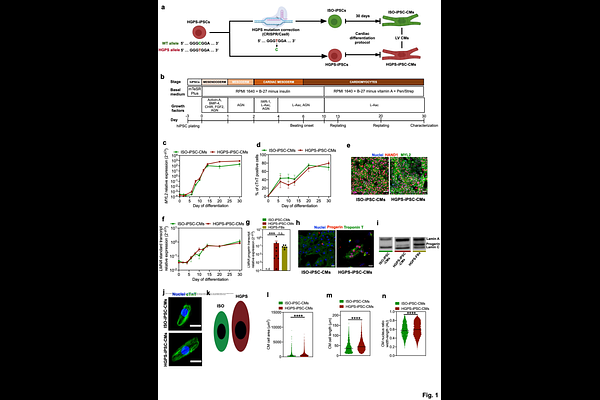Lonafarnib Partially Reverses Cardiac Senescence in Human and Mouse Progeria Models via Autophagy Activation

Lonafarnib Partially Reverses Cardiac Senescence in Human and Mouse Progeria Models via Autophagy Activation
Monteiro, L. M.; Pitrez, P. R.; Correira-Santos, S.; Dark, N.; Santinha, D.; Aveleira, C.; Townsend, M.; Taylor, J.; Nissan, X.; Sardao, V.; Cortes, L.; Mitter, R.; Marino, A.; Sousa-Soares, C.; Ribeiro, R.; Smith, J. C.; Logarinho, E.; Ori, A.; Bernardo, A. S.; Ferreira, L.
AbstractHutchinson-Gilford Progeria Syndrome (HGPS), characterised by accelerated ageing, causes cardiovascular defects resembling aspects of cardiovascular ageing. We used human left ventricle cardiomyocytes (CMs) derived from HGPS-induced pluripotent stem cells (iPSCs), and their isogenic-corrected controls, to investigate HGPS-CM dysfunction and identify potential therapies. Our results revealed that HGPS-iPSC-CMs exhibit greater maturity and associated elevated oxidative stress compared to controls, which they could not contend with, leading to cellular senescence. Increased senescence was also observed in cardiac tissue from mouse and human physiologically-aged and HGPS individuals. Functionally, HGPS-iPSC-CMs showed dysregulated mitochondrial respiration and calcium handling. Amongst the six drugs tested, rapamycin and lonafarnib were the most effective against HGPS-cardiac phenotypes. Although lonafarnib raised safety concerns, it partially reverted the cardiac senescent phenotype by inducing cellular autophagy and decreasing progerin expression in progeroid mice. Our study supports the use of HGPS-iPSC-CMs to identify novel biomarkers and therapies for HGPS, and potentially cardiac physiological-ageing.